Spinal Cord Injuries: Incidence, Types, and Resources
VerifiedAdded on 2021/06/18
|7
|1732
|100
Report
AI Summary
This report provides an overview of spinal cord injuries (SCI), encompassing their incidence, causes, and types, with a specific focus on the Australian context. It details both traumatic and non-traumatic causes, including statistics from the Australian Spinal Cord Injury Registry (ASCIR), and categorizes SCI into complete and incomplete injuries, further differentiating between paraplegia, tetraplegia, and triplegia. The report highlights various types of partial spinal cord injuries, such as Anterior cord syndrome, Brown Sequard syndrome, and Central cord syndrome. Additionally, it introduces the South Australia Spinal Cord Injury Services (SASCIS) as a key community resource for SCI patients, detailing the range of services provided. The report concludes by emphasizing the significance of management strategies, including physical therapy, surgery, and medication, in mitigating the debilitating effects of SCI, and the availability of medical and research centers in Australia. The report aims to provide a comprehensive understanding of SCI, its implications, and available support systems.
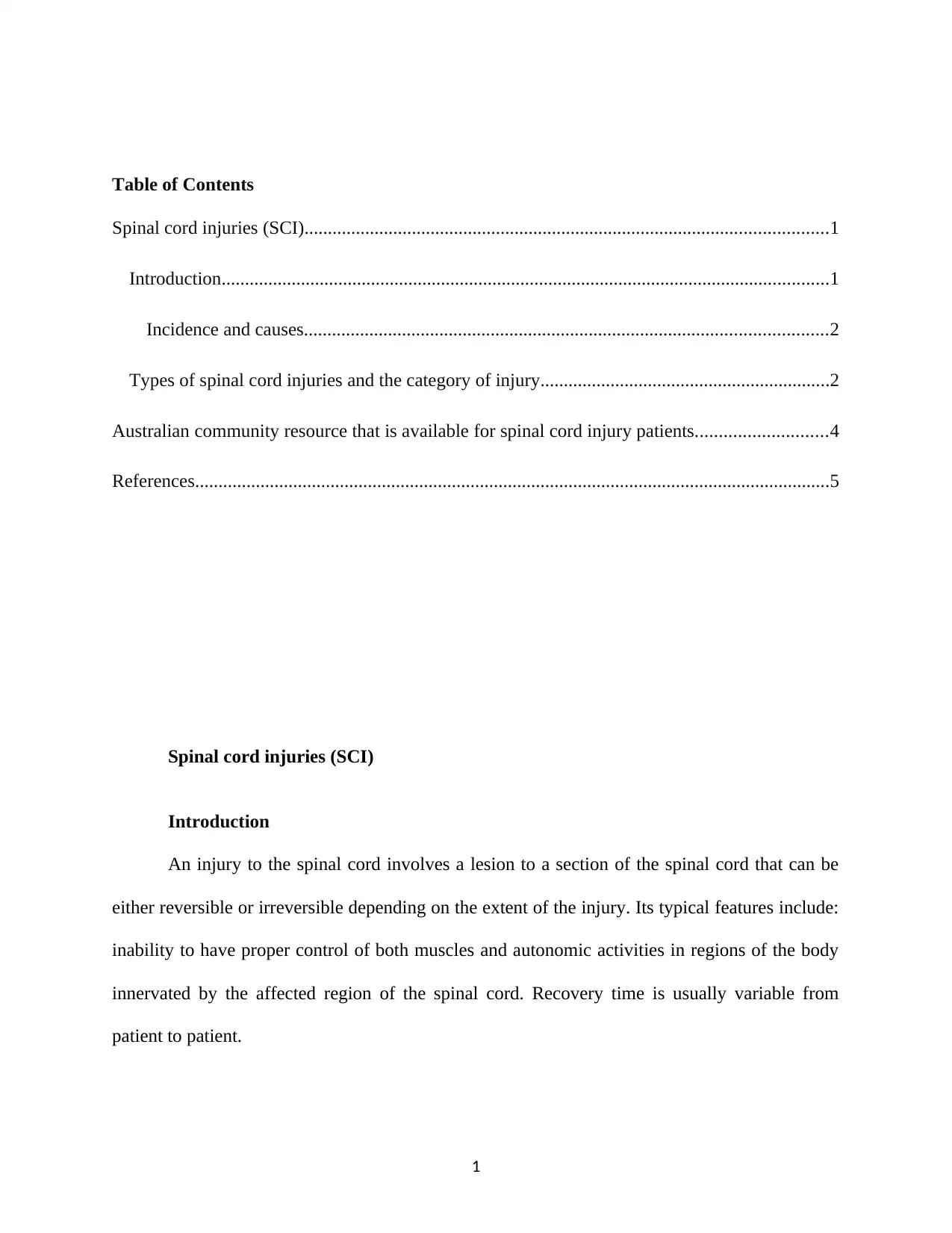
Table of Contents
Spinal cord injuries (SCI)................................................................................................................1
Introduction..................................................................................................................................1
Incidence and causes................................................................................................................2
Types of spinal cord injuries and the category of injury..............................................................2
Australian community resource that is available for spinal cord injury patients............................4
References........................................................................................................................................5
Spinal cord injuries (SCI)
Introduction
An injury to the spinal cord involves a lesion to a section of the spinal cord that can be
either reversible or irreversible depending on the extent of the injury. Its typical features include:
inability to have proper control of both muscles and autonomic activities in regions of the body
innervated by the affected region of the spinal cord. Recovery time is usually variable from
patient to patient.
1
Spinal cord injuries (SCI)................................................................................................................1
Introduction..................................................................................................................................1
Incidence and causes................................................................................................................2
Types of spinal cord injuries and the category of injury..............................................................2
Australian community resource that is available for spinal cord injury patients............................4
References........................................................................................................................................5
Spinal cord injuries (SCI)
Introduction
An injury to the spinal cord involves a lesion to a section of the spinal cord that can be
either reversible or irreversible depending on the extent of the injury. Its typical features include:
inability to have proper control of both muscles and autonomic activities in regions of the body
innervated by the affected region of the spinal cord. Recovery time is usually variable from
patient to patient.
1
Paraphrase This Document
Need a fresh take? Get an instant paraphrase of this document with our AI Paraphraser
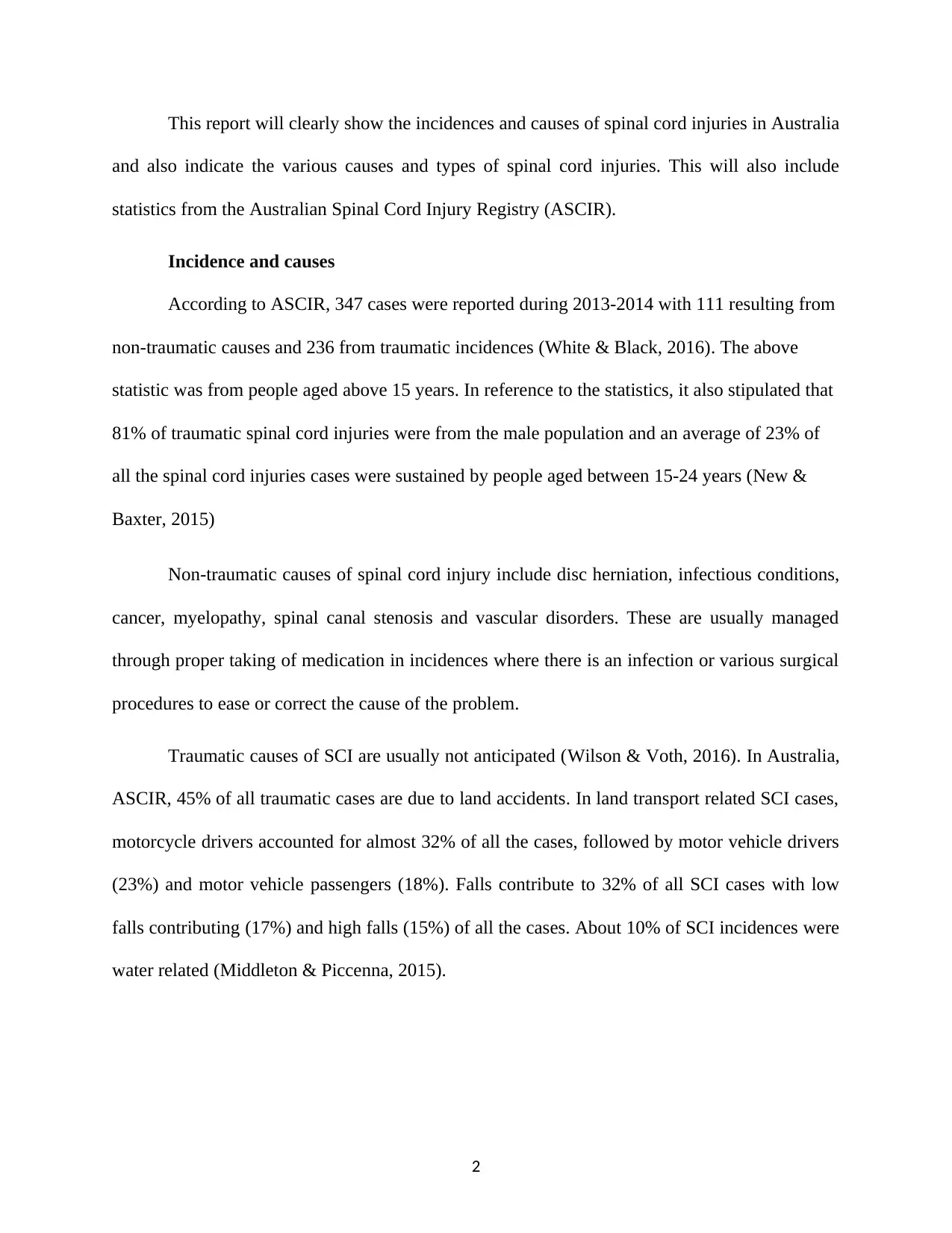
This report will clearly show the incidences and causes of spinal cord injuries in Australia
and also indicate the various causes and types of spinal cord injuries. This will also include
statistics from the Australian Spinal Cord Injury Registry (ASCIR).
Incidence and causes
According to ASCIR, 347 cases were reported during 2013-2014 with 111 resulting from
non-traumatic causes and 236 from traumatic incidences (White & Black, 2016). The above
statistic was from people aged above 15 years. In reference to the statistics, it also stipulated that
81% of traumatic spinal cord injuries were from the male population and an average of 23% of
all the spinal cord injuries cases were sustained by people aged between 15-24 years (New &
Baxter, 2015)
Non-traumatic causes of spinal cord injury include disc herniation, infectious conditions,
cancer, myelopathy, spinal canal stenosis and vascular disorders. These are usually managed
through proper taking of medication in incidences where there is an infection or various surgical
procedures to ease or correct the cause of the problem.
Traumatic causes of SCI are usually not anticipated (Wilson & Voth, 2016). In Australia,
ASCIR, 45% of all traumatic cases are due to land accidents. In land transport related SCI cases,
motorcycle drivers accounted for almost 32% of all the cases, followed by motor vehicle drivers
(23%) and motor vehicle passengers (18%). Falls contribute to 32% of all SCI cases with low
falls contributing (17%) and high falls (15%) of all the cases. About 10% of SCI incidences were
water related (Middleton & Piccenna, 2015).
2
and also indicate the various causes and types of spinal cord injuries. This will also include
statistics from the Australian Spinal Cord Injury Registry (ASCIR).
Incidence and causes
According to ASCIR, 347 cases were reported during 2013-2014 with 111 resulting from
non-traumatic causes and 236 from traumatic incidences (White & Black, 2016). The above
statistic was from people aged above 15 years. In reference to the statistics, it also stipulated that
81% of traumatic spinal cord injuries were from the male population and an average of 23% of
all the spinal cord injuries cases were sustained by people aged between 15-24 years (New &
Baxter, 2015)
Non-traumatic causes of spinal cord injury include disc herniation, infectious conditions,
cancer, myelopathy, spinal canal stenosis and vascular disorders. These are usually managed
through proper taking of medication in incidences where there is an infection or various surgical
procedures to ease or correct the cause of the problem.
Traumatic causes of SCI are usually not anticipated (Wilson & Voth, 2016). In Australia,
ASCIR, 45% of all traumatic cases are due to land accidents. In land transport related SCI cases,
motorcycle drivers accounted for almost 32% of all the cases, followed by motor vehicle drivers
(23%) and motor vehicle passengers (18%). Falls contribute to 32% of all SCI cases with low
falls contributing (17%) and high falls (15%) of all the cases. About 10% of SCI incidences were
water related (Middleton & Piccenna, 2015).
2
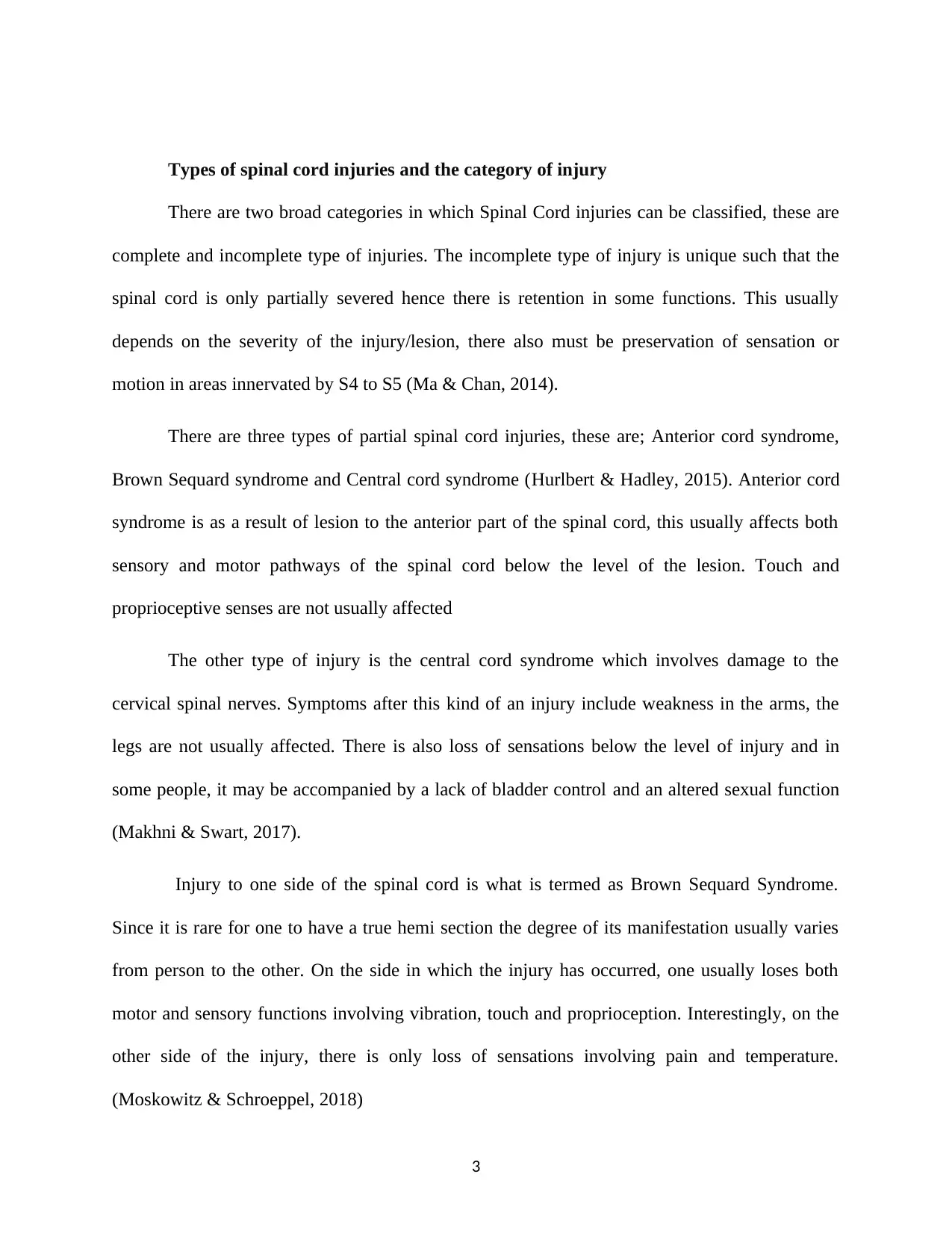
Types of spinal cord injuries and the category of injury
There are two broad categories in which Spinal Cord injuries can be classified, these are
complete and incomplete type of injuries. The incomplete type of injury is unique such that the
spinal cord is only partially severed hence there is retention in some functions. This usually
depends on the severity of the injury/lesion, there also must be preservation of sensation or
motion in areas innervated by S4 to S5 (Ma & Chan, 2014).
There are three types of partial spinal cord injuries, these are; Anterior cord syndrome,
Brown Sequard syndrome and Central cord syndrome (Hurlbert & Hadley, 2015). Anterior cord
syndrome is as a result of lesion to the anterior part of the spinal cord, this usually affects both
sensory and motor pathways of the spinal cord below the level of the lesion. Touch and
proprioceptive senses are not usually affected
The other type of injury is the central cord syndrome which involves damage to the
cervical spinal nerves. Symptoms after this kind of an injury include weakness in the arms, the
legs are not usually affected. There is also loss of sensations below the level of injury and in
some people, it may be accompanied by a lack of bladder control and an altered sexual function
(Makhni & Swart, 2017).
Injury to one side of the spinal cord is what is termed as Brown Sequard Syndrome.
Since it is rare for one to have a true hemi section the degree of its manifestation usually varies
from person to the other. On the side in which the injury has occurred, one usually loses both
motor and sensory functions involving vibration, touch and proprioception. Interestingly, on the
other side of the injury, there is only loss of sensations involving pain and temperature.
(Moskowitz & Schroeppel, 2018)
3
There are two broad categories in which Spinal Cord injuries can be classified, these are
complete and incomplete type of injuries. The incomplete type of injury is unique such that the
spinal cord is only partially severed hence there is retention in some functions. This usually
depends on the severity of the injury/lesion, there also must be preservation of sensation or
motion in areas innervated by S4 to S5 (Ma & Chan, 2014).
There are three types of partial spinal cord injuries, these are; Anterior cord syndrome,
Brown Sequard syndrome and Central cord syndrome (Hurlbert & Hadley, 2015). Anterior cord
syndrome is as a result of lesion to the anterior part of the spinal cord, this usually affects both
sensory and motor pathways of the spinal cord below the level of the lesion. Touch and
proprioceptive senses are not usually affected
The other type of injury is the central cord syndrome which involves damage to the
cervical spinal nerves. Symptoms after this kind of an injury include weakness in the arms, the
legs are not usually affected. There is also loss of sensations below the level of injury and in
some people, it may be accompanied by a lack of bladder control and an altered sexual function
(Makhni & Swart, 2017).
Injury to one side of the spinal cord is what is termed as Brown Sequard Syndrome.
Since it is rare for one to have a true hemi section the degree of its manifestation usually varies
from person to the other. On the side in which the injury has occurred, one usually loses both
motor and sensory functions involving vibration, touch and proprioception. Interestingly, on the
other side of the injury, there is only loss of sensations involving pain and temperature.
(Moskowitz & Schroeppel, 2018)
3
You're viewing a preview
Unlock full access by subscribing today!
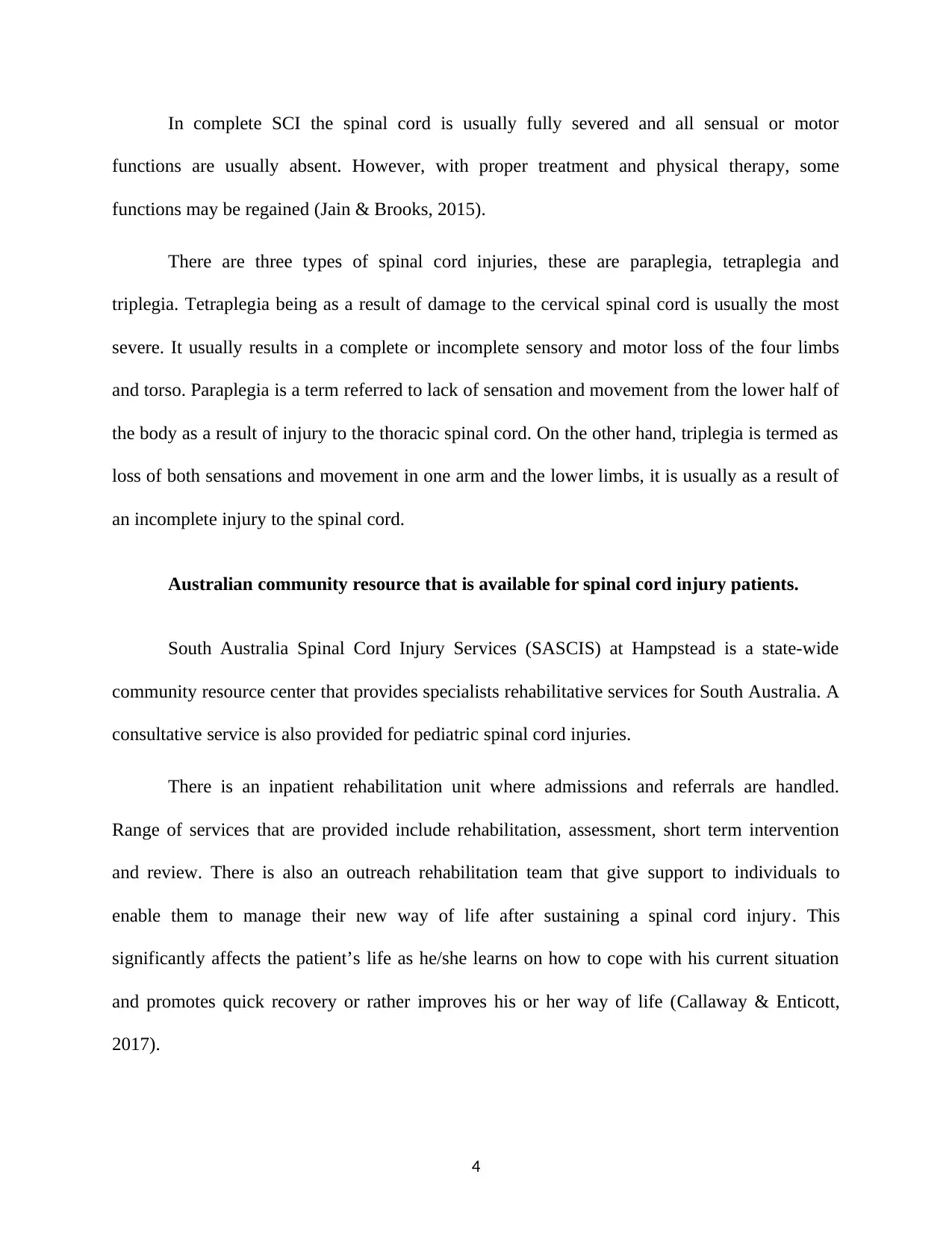
In complete SCI the spinal cord is usually fully severed and all sensual or motor
functions are usually absent. However, with proper treatment and physical therapy, some
functions may be regained (Jain & Brooks, 2015).
There are three types of spinal cord injuries, these are paraplegia, tetraplegia and
triplegia. Tetraplegia being as a result of damage to the cervical spinal cord is usually the most
severe. It usually results in a complete or incomplete sensory and motor loss of the four limbs
and torso. Paraplegia is a term referred to lack of sensation and movement from the lower half of
the body as a result of injury to the thoracic spinal cord. On the other hand, triplegia is termed as
loss of both sensations and movement in one arm and the lower limbs, it is usually as a result of
an incomplete injury to the spinal cord.
Australian community resource that is available for spinal cord injury patients.
South Australia Spinal Cord Injury Services (SASCIS) at Hampstead is a state-wide
community resource center that provides specialists rehabilitative services for South Australia. A
consultative service is also provided for pediatric spinal cord injuries.
There is an inpatient rehabilitation unit where admissions and referrals are handled.
Range of services that are provided include rehabilitation, assessment, short term intervention
and review. There is also an outreach rehabilitation team that give support to individuals to
enable them to manage their new way of life after sustaining a spinal cord injury. This
significantly affects the patient’s life as he/she learns on how to cope with his current situation
and promotes quick recovery or rather improves his or her way of life (Callaway & Enticott,
2017).
4
functions are usually absent. However, with proper treatment and physical therapy, some
functions may be regained (Jain & Brooks, 2015).
There are three types of spinal cord injuries, these are paraplegia, tetraplegia and
triplegia. Tetraplegia being as a result of damage to the cervical spinal cord is usually the most
severe. It usually results in a complete or incomplete sensory and motor loss of the four limbs
and torso. Paraplegia is a term referred to lack of sensation and movement from the lower half of
the body as a result of injury to the thoracic spinal cord. On the other hand, triplegia is termed as
loss of both sensations and movement in one arm and the lower limbs, it is usually as a result of
an incomplete injury to the spinal cord.
Australian community resource that is available for spinal cord injury patients.
South Australia Spinal Cord Injury Services (SASCIS) at Hampstead is a state-wide
community resource center that provides specialists rehabilitative services for South Australia. A
consultative service is also provided for pediatric spinal cord injuries.
There is an inpatient rehabilitation unit where admissions and referrals are handled.
Range of services that are provided include rehabilitation, assessment, short term intervention
and review. There is also an outreach rehabilitation team that give support to individuals to
enable them to manage their new way of life after sustaining a spinal cord injury. This
significantly affects the patient’s life as he/she learns on how to cope with his current situation
and promotes quick recovery or rather improves his or her way of life (Callaway & Enticott,
2017).
4
Paraphrase This Document
Need a fresh take? Get an instant paraphrase of this document with our AI Paraphraser
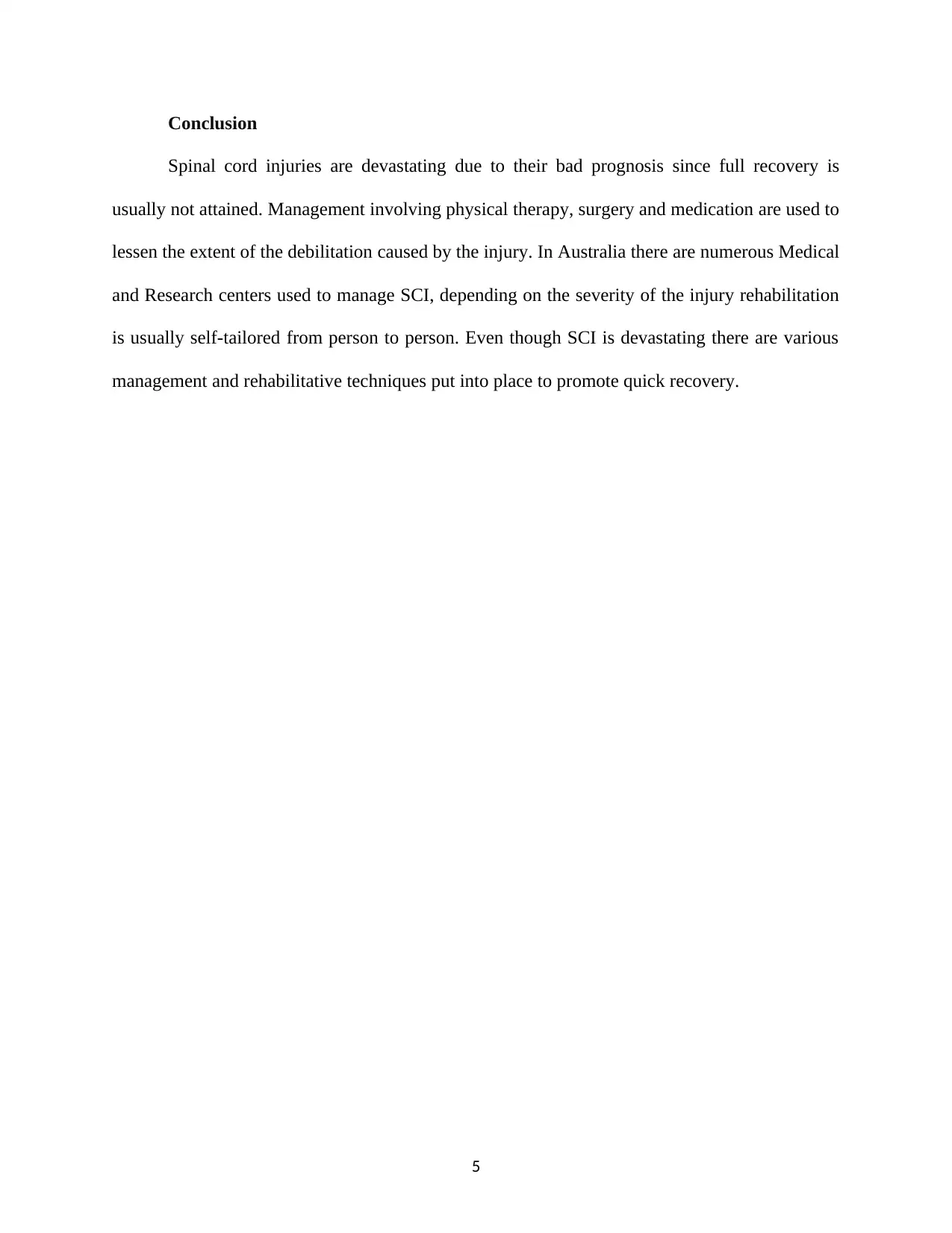
Conclusion
Spinal cord injuries are devastating due to their bad prognosis since full recovery is
usually not attained. Management involving physical therapy, surgery and medication are used to
lessen the extent of the debilitation caused by the injury. In Australia there are numerous Medical
and Research centers used to manage SCI, depending on the severity of the injury rehabilitation
is usually self-tailored from person to person. Even though SCI is devastating there are various
management and rehabilitative techniques put into place to promote quick recovery.
5
Spinal cord injuries are devastating due to their bad prognosis since full recovery is
usually not attained. Management involving physical therapy, surgery and medication are used to
lessen the extent of the debilitation caused by the injury. In Australia there are numerous Medical
and Research centers used to manage SCI, depending on the severity of the injury rehabilitation
is usually self-tailored from person to person. Even though SCI is devastating there are various
management and rehabilitative techniques put into place to promote quick recovery.
5
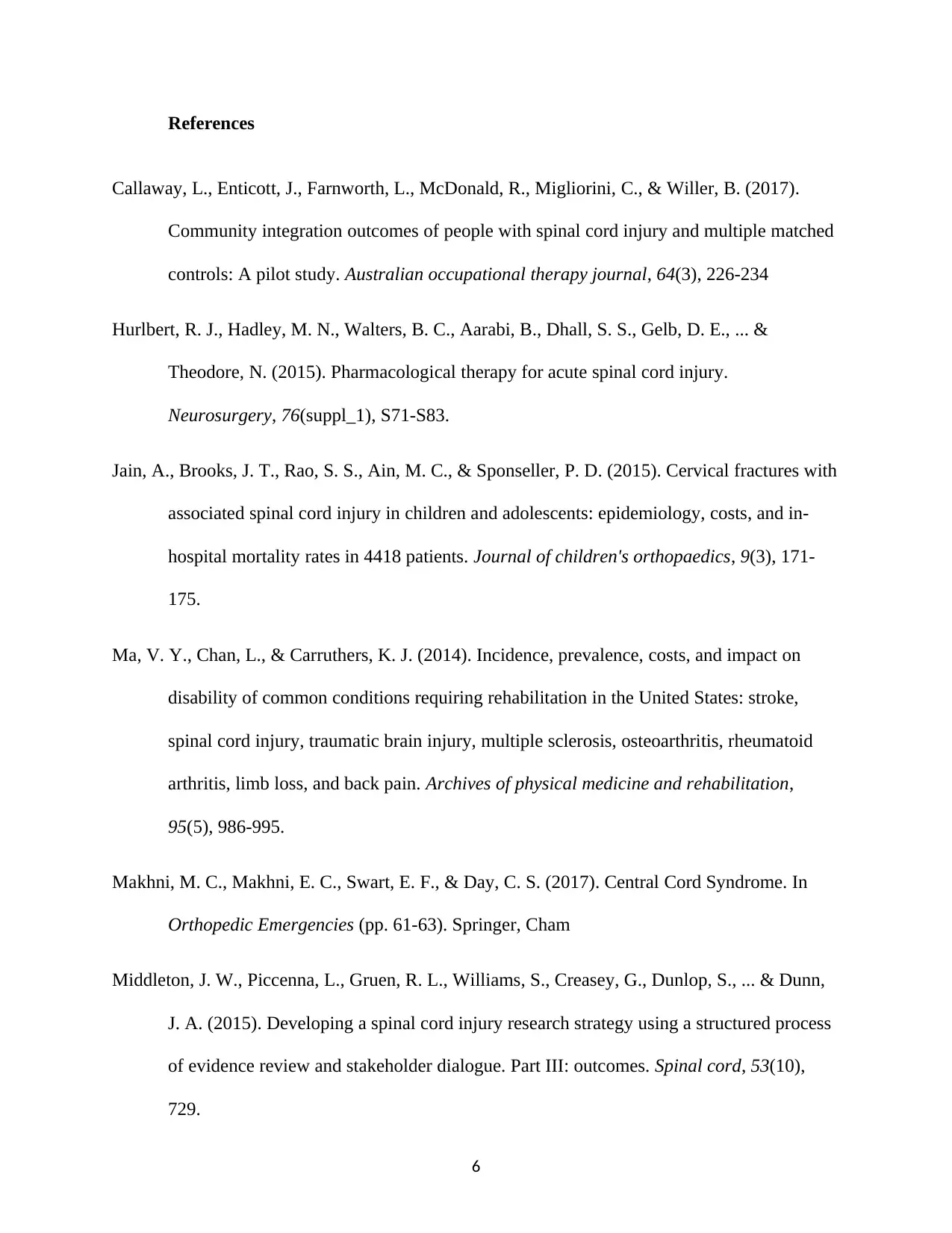
References
Callaway, L., Enticott, J., Farnworth, L., McDonald, R., Migliorini, C., & Willer, B. (2017).
Community integration outcomes of people with spinal cord injury and multiple matched
controls: A pilot study. Australian occupational therapy journal, 64(3), 226-234
Hurlbert, R. J., Hadley, M. N., Walters, B. C., Aarabi, B., Dhall, S. S., Gelb, D. E., ... &
Theodore, N. (2015). Pharmacological therapy for acute spinal cord injury.
Neurosurgery, 76(suppl_1), S71-S83.
Jain, A., Brooks, J. T., Rao, S. S., Ain, M. C., & Sponseller, P. D. (2015). Cervical fractures with
associated spinal cord injury in children and adolescents: epidemiology, costs, and in-
hospital mortality rates in 4418 patients. Journal of children's orthopaedics, 9(3), 171-
175.
Ma, V. Y., Chan, L., & Carruthers, K. J. (2014). Incidence, prevalence, costs, and impact on
disability of common conditions requiring rehabilitation in the United States: stroke,
spinal cord injury, traumatic brain injury, multiple sclerosis, osteoarthritis, rheumatoid
arthritis, limb loss, and back pain. Archives of physical medicine and rehabilitation,
95(5), 986-995.
Makhni, M. C., Makhni, E. C., Swart, E. F., & Day, C. S. (2017). Central Cord Syndrome. In
Orthopedic Emergencies (pp. 61-63). Springer, Cham
Middleton, J. W., Piccenna, L., Gruen, R. L., Williams, S., Creasey, G., Dunlop, S., ... & Dunn,
J. A. (2015). Developing a spinal cord injury research strategy using a structured process
of evidence review and stakeholder dialogue. Part III: outcomes. Spinal cord, 53(10),
729.
6
Callaway, L., Enticott, J., Farnworth, L., McDonald, R., Migliorini, C., & Willer, B. (2017).
Community integration outcomes of people with spinal cord injury and multiple matched
controls: A pilot study. Australian occupational therapy journal, 64(3), 226-234
Hurlbert, R. J., Hadley, M. N., Walters, B. C., Aarabi, B., Dhall, S. S., Gelb, D. E., ... &
Theodore, N. (2015). Pharmacological therapy for acute spinal cord injury.
Neurosurgery, 76(suppl_1), S71-S83.
Jain, A., Brooks, J. T., Rao, S. S., Ain, M. C., & Sponseller, P. D. (2015). Cervical fractures with
associated spinal cord injury in children and adolescents: epidemiology, costs, and in-
hospital mortality rates in 4418 patients. Journal of children's orthopaedics, 9(3), 171-
175.
Ma, V. Y., Chan, L., & Carruthers, K. J. (2014). Incidence, prevalence, costs, and impact on
disability of common conditions requiring rehabilitation in the United States: stroke,
spinal cord injury, traumatic brain injury, multiple sclerosis, osteoarthritis, rheumatoid
arthritis, limb loss, and back pain. Archives of physical medicine and rehabilitation,
95(5), 986-995.
Makhni, M. C., Makhni, E. C., Swart, E. F., & Day, C. S. (2017). Central Cord Syndrome. In
Orthopedic Emergencies (pp. 61-63). Springer, Cham
Middleton, J. W., Piccenna, L., Gruen, R. L., Williams, S., Creasey, G., Dunlop, S., ... & Dunn,
J. A. (2015). Developing a spinal cord injury research strategy using a structured process
of evidence review and stakeholder dialogue. Part III: outcomes. Spinal cord, 53(10),
729.
6
You're viewing a preview
Unlock full access by subscribing today!
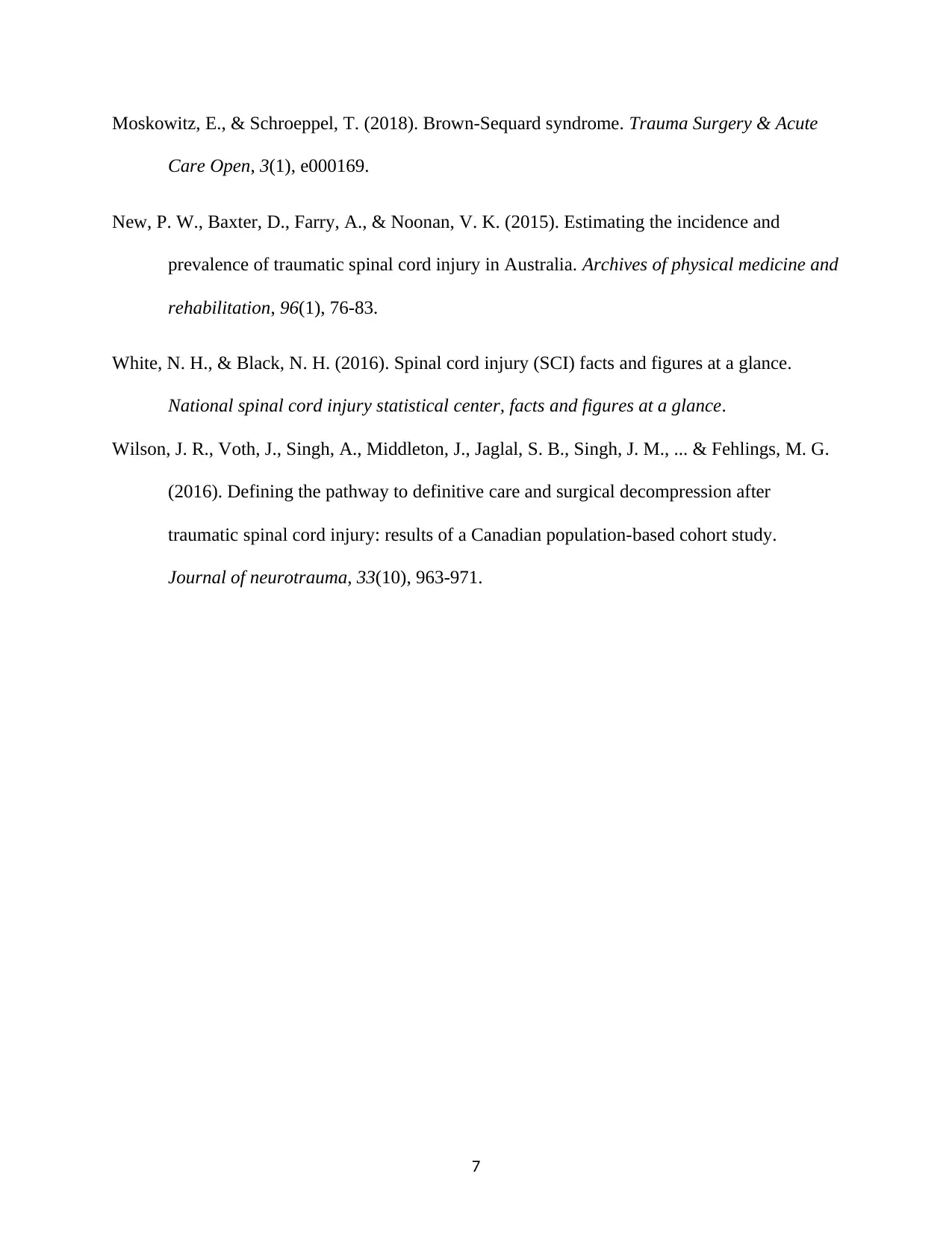
Moskowitz, E., & Schroeppel, T. (2018). Brown-Sequard syndrome. Trauma Surgery & Acute
Care Open, 3(1), e000169.
New, P. W., Baxter, D., Farry, A., & Noonan, V. K. (2015). Estimating the incidence and
prevalence of traumatic spinal cord injury in Australia. Archives of physical medicine and
rehabilitation, 96(1), 76-83.
White, N. H., & Black, N. H. (2016). Spinal cord injury (SCI) facts and figures at a glance.
National spinal cord injury statistical center, facts and figures at a glance.
Wilson, J. R., Voth, J., Singh, A., Middleton, J., Jaglal, S. B., Singh, J. M., ... & Fehlings, M. G.
(2016). Defining the pathway to definitive care and surgical decompression after
traumatic spinal cord injury: results of a Canadian population-based cohort study.
Journal of neurotrauma, 33(10), 963-971.
7
Care Open, 3(1), e000169.
New, P. W., Baxter, D., Farry, A., & Noonan, V. K. (2015). Estimating the incidence and
prevalence of traumatic spinal cord injury in Australia. Archives of physical medicine and
rehabilitation, 96(1), 76-83.
White, N. H., & Black, N. H. (2016). Spinal cord injury (SCI) facts and figures at a glance.
National spinal cord injury statistical center, facts and figures at a glance.
Wilson, J. R., Voth, J., Singh, A., Middleton, J., Jaglal, S. B., Singh, J. M., ... & Fehlings, M. G.
(2016). Defining the pathway to definitive care and surgical decompression after
traumatic spinal cord injury: results of a Canadian population-based cohort study.
Journal of neurotrauma, 33(10), 963-971.
7
1 out of 7
Your All-in-One AI-Powered Toolkit for Academic Success.
+13062052269
info@desklib.com
Available 24*7 on WhatsApp / Email
![[object Object]](/_next/static/media/star-bottom.7253800d.svg)
Unlock your academic potential
© 2024 | Zucol Services PVT LTD | All rights reserved.

